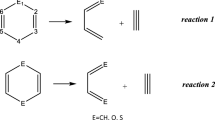Abstract
The problem of the unit slope of the Brønsted plot for the proton transfer reaction from the “hard” CH-acids is considered by the example of a series of gas-phase deprotonation reactions of substituted benzenes with the CH2CN– anion. The discussion is conducted within the framework of the theory of non-equilibrium reactions. The use of intramolecular reorganization (IMR) method allows calculate directly the structure and energy of the activated complex. A comparison is made of two models. In model 1, as with the standard approach, proton tunnelling process is associated with the system potential V(r) (r is proton coordinate), whereas in model 2, it is associated with the potential of reaction zone X (including the breaking (A‒H) and formed (H‒B) bonds), VX(r). The VX energy has been calculated using the Mayer’s APOST program, designed to calculate the mono- and diatomic components of the system energy. The accepted level of calculation of the energies V and VX (HF/6-31G**//HF/3-21G**) has been determined by APOST program capabilities. Key feature of model 2 is almost complete insensitivity of the proton tunneling frequency, νt, to changes of reaction energy ΔE00. The end result is an increase of the Brønsted coefficient α from 0.67 (for model 1) to 0.83. It is shown that when going from the gas phase to the solution (reaction in DMSO medium), α value increases to 0.97.






Similar content being viewed by others
Notes
It is assumed that the position of the minima in the V* and V potentials coincides.
A priori we define the AC positions on the structural coordinate in models 1 and 2 as not the same. In fact, \(\rho _{1}^{*}\)= \(\rho _{2}^{*}\) (see below).
As can be seen, none of these reactions is barrier-free. Generally speaking, it is difficult to expect the barrier-free mechanism to be common for a sufficiently extended reaction series; in this case, in particular, the energy ΔЕ00 interval within the series is 28 kcal/mol (Table 3).
REFERENCES
I. A. Romanskii, Comput. Theor. Chem. 1127, 52 (2018). https://doi.org/10.1016/j.comptc.2018.01.019
J. N. Broensted and K. Pedersen, Z. Phys. Chem. 108, 185 (1924). https://doi.org/10.1515/zpch-1924-10814
A. I. Shatenshtein, Adv. Phys. Org. Chem. 1, 155 (1963). https://doi.org/10.1016/S0065-3160(08)60278-6
A. Streitwieser, P. C. Mowery, R. G. Jesaites, J. R. Wright, P. H. Owens, and D. M. E. Reuben, in Proceedings of the Jerusalem Symposium on Quantum Chemistry and Biochemistry,1970, Vol. 2, p. 160.
M. Szwarc, A. Streitwieser, and P. C. Mowery, in Ions and Ion Pairs in Organic Reactions, Ed. by M. Szwarc (Wiley, New York, 1974), p. 171.
A. Streitwieser, R. A. Caldwell, R. G. Lawler, and G. R. Ziegler, J. Am. Chem. Soc. 87, 5399 (1965). https://doi.org/10.1021/ja00951a026
I. O. Shapiro, Yu. I. Ranneva, and A. I. Shatenshtein, Russ. J. Gen. Chem. 49, 2030 (1979).
A. Streitwieser, J. Q. Hudson, and F. Mares, J. Am. Chem. Soc. 90, 648 (1968). https://doi.org/10.1021/ja01005a017
C. D. Broaddus, J. Org. Chem. 35, 10 (1970). https://doi.org/10.1021/jo00826a003
A. A. Streitwieser, P. J. Scannon, and H. M. Niemeyer, J. Am. Chem. Soc. 94, 7936 (1972). https://doi.org/10.1021/ja00777a053
R. P. Bell and S. Grainger, J. Chem. Soc., Perkin Trans. 2, No. 12, 1367 (1976). https://doi.org/10.1039/p29760001367
A. Streitwieser, D. Holtz, G. R. Ziegler, J. O. Stoffer, M. L. Brokaw, and F. Guibe, J. Am. Chem. Soc. 98, 5229 (1976). https://doi.org/10.1021/ja00433a030
A. I. Shatenshtein, L. I. Zakharkin, E. S. Petrov, E. A. Yakovleva, F. S. Yakushin, Z. Vukmirovich, G. G. Isaeva, and V. N. Kalinin, J. Organomet. Chem. 23, 313 (1970). https://doi.org/10.1016/S0022-328X(00)92944-9
A. Streitwieser, K. Shah, J. R. Reyes, X. Zhang, N. R. Davis, and E. C. Wu, J. Phys. Chem. A 114, 8793 (2010). https://doi.org/10.1021/jp101791e
N. G. Zharova, Ju. I. Ranneva, E. D. German, and I. O. Shapiro, Russ. J. Phys. Chem. 64, 1537 (1990).
V. G. Levich, R. R. Dogonadze, E. D. German, et al., Electrochim. Acta 15, 353 (1970). https://doi.org/10.1016/0013-4686(70)80027-5
E. D. German and R. R. Dogonadze, in The Proton in the Chemistry, Ed. by R. P. Bell (Springer, New York, 1977), Supplement, p. 350.
R. A. Marcus, J. Phys. Chem. 72, 891 (1968). https://doi.org/10.1021/j100849a019
A. D. Cohen and R. A. Marcus, J. Phys. Chem. 72, 4249 (1968). https://doi.org/10.1021/j100858a052
I. A. Romanskii, Russ. Chem. Bull. 57, 1843 (2008). https://doi.org/10.1007/s11172-008-0249-7
A. M. Kuznetsov, J. Electroanal. Chem. 204, 97 (1986).
A. Hamza and I. Mayer, Theor. Chem. Acc. 109, 91 (2003). https://doi.org/10.1007/s00214-002-0426-y
I. Mayer, Phys. Chem. Chem. Phys. 8, 4630 (2006). https://doi.org/10.1039/C1CP22476J
I. Mayer and A. Hamza, APOST, Version 1.0, 2000. http://occam.chemres.hu/programs.
M. J. Frisch, G. W. Trucks, H. B. Schlegel, G. E. Scuseria, M. A. Robb, J. R. Cheeseman, J. A. Montgomery, Jr., T. Vreven, K. N. Kudin, J. C. Burant, J. M. Millam, S. S. Iyengar, J. Tomasi, V. Barone, B. Mennucci, et al., Gaussian 03, Revision C.02 (Gaussian Inc., Wallingford CT, 2004).
R. L. Samorai and D. F. Hornig, J. Chem. Phys. 36, 1980 (1962). https://doi.org/10.1063/1.1732814
https://www.python3.x.docs.
J. Brickmann, in The Hydrogen Bond–Recent Developments in Theory and Experiments, Ed. by P. Schuster, G. Zandel, and C. Sandorfy (North-Holland, Amsterdam, 1976), p. 217.
M. M. Szczesniak and S. Scheiner, J. Phys. Chem. 89, 1835 (1985). https://doi.org/10.1021/j100255a059
ACKNOWLEDGMENTS
The author would like to thank M.V. Basilevsky for valuable remarks.
Author information
Authors and Affiliations
Corresponding author
Rights and permissions
About this article
Cite this article
Romanskii, I.A. Analysis of the Brønsted Relation in the Framework of the Non-equilibrium Approach. The Gas-Phase Reactions of Benzenes with the CH2CN– Anion. Russ. J. Phys. Chem. 94, 1866–1876 (2020). https://doi.org/10.1134/S003602442009023X
Received:
Revised:
Accepted:
Published:
Issue Date:
DOI: https://doi.org/10.1134/S003602442009023X




